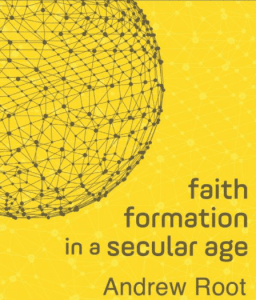 In Andrew Root’s Faith Formation in a Secular Age, Root sketches three kinds of Secular:
In Andrew Root’s Faith Formation in a Secular Age, Root sketches three kinds of Secular:
Secular 1: Sacred versus Secular Planes
Secular 2: Religious versus A-religious Spaces
Secular 3: The Negating of Transcendence
What happens to faith in Secular 3? Faith in Secular 2 is joining and participating in an organization, an institution, a church. “In Christ” then means “in the church,” and he appeals here to Bultmann.
What are the elements of faith in Secular 3? Root contends, and this chapter (9) is both interesting and critical for comprehending his project, that two elements are necessary: experience and personhood.
It is about “union with Christ,” but union is not the erasure of personality into infinity or divinity. It is hypostatic in the sense of the union of two persons into a permeating union that leaves each viable. Experience and personhood are at the heart of this union with Christ.
Some words of his about each, beginning with redemption as union with Christ as being “in” Christ, and anything in Christ is caught up into the story of the cross and negation:
Paul sees this as a union (a kind of participation in being) because he discovers that his own person is now bound with the person of Jesus Christ. And it is bound there through negation itself. Paul understands himself quite literally “in Christ”: his being is now in Christ’s being, as Christ is in him, because Paul has died with Christ, and through death Jesus has brought him into a new reality made through the ministerial action of the persons of the triune God (again, Gal. 2:20).
To be in Christ” is to encounter the opposite in collision. It is to find the divine in the human, life in suffering, strength in weakness, righteousness in curse, and the apostle in the murderous persecutor.
In Secular 3 in the age of authenticity faith takes on distinct senses and challenges Secular 3:
But while Paul’s contention for a new realm may seem antiquated (or at least odd) against the pull of Secular 3, the very way Paul’s contention and Secular 3 collide breaks open a way for us to imagine “in Christ” as a transcendent (mystical) union even in our time. Secular 3’s age of authenticity makes “experience” of the “personal” central. While Secular 3 beats down transcendence/divine action and the thought that being could be found anywhere other than in the material and natural (the immanent frame), the age of authenticity nevertheless opposes Secular 3’s temptation to flatten the importance of experience and refuses to give the world over completely to the impersonal.
It’s not easy; it’s a collision course and humans in Secular 3 resist faith formation:
This, of course, leads to tension. The buffered self, which is dependent on both the disenchantment of Secular 3 and the romanticism of the age of authenticity, is by definition closed (buffered) from transcendent events or foreign ontological encounters. The age of authenticity then is tempted to spin closed so that the self remains always a free agent.
Everything about faith formation in Secular 3 is about an experience and valuing the experience of each is central to mission — the mission of God and participating in the mission of God:
This reality that is Christ comes upon Paul as an experience. To be “in Christ” is to be upended by an experience. As James Dunn says, “At the heart of the motif is not merely a belief about Christ, but an experience understood as that of the risen and living Christ.”
Experience transcends information, confession, creed, theology:
For Paul, there is no other way. To believe is not to hold or to commit to information that qualifies you as a member, but it is to trust experience. It is to follow the experience of the living Christ, who comes to minister to you. This experience might be your own, like Paul’s on the road to Damascus, or it might be the story told within the household of faith (within the ecclesia/church). Regardless, the only way into this realm called Christ is to follow experience.
To experience Christ is to experience the story of Christ; it is not to colonize Christ for our own story but to enter into the story of Christ:
Whether it is you or someone else who has this direct experience with the living Christ, its very shape (if it is indeed Jesus), Paul believes, will take the form of the cross—faith for Paul is not vital or consequential; it is only cruciform.
We experience the cross in our many death experiences (that is, our encounters with rejection, loss, and fear, those moments when we feel our being in question, alone to face the darkness) .
Experience comes at a price; it de-institutionalizes; it breaks out of conformity; it resists the age of obligation; it becomes central to faith formation:
In the age of authenticity, our experiences equal our reality. But because they are our experiences, they can be doubted and never presumed to hold direct normative weight for anyone else. In the age of authenticity I will always allow you to have your experience, but until I have an experience myself, it will make little demand on me.
But the age of authenticity also demands that as you tell of your own experience—say, an experience of feeling God’s presence as you pray in the midst of marital turmoil or a child’s illness—if I have a moving experience in hearing you, I may agree that Christ has come to me.
In the age of authenticity, we no longer give ourselves over to orders and duties (or even intellectual arguments based on some disconnected reason), believing them to be more real than our own experience. Rather, experience itself becomes the measure of what is. This experiential focus can spin us into heavy expressive bohemianism that births a radical individualism.
The danger of experience is subjectivism and radical individualism; there must be a genuine person to encounter — Christ himself — for it to be a Christian experience and to be authentic; it must be hypostatic:
To call this “in Christ” a mystical union is to recognize its experiential core. But for this core not to disappear into subjectivism, we must also recognize the experiential within personhood. To be “in Christ” is to have an experience of the person of Jesus encountering our own person.
Hypostasis, from the perspective of the Cappadocians, is a zone where the divine and the human not only intermingle but, more so, find a deep union of distinct but mutual sharing.
Faith now begins to be clarified; faith is hyper-personal:
Faith itself is to have your being (your person) in the person of Jesus Christ. Faith is the experience of sharing in the person of Christ. If faith is fidelity and loyalty to a new realm, this realm is nothing more than the very person of Jesus himself.
This is, obviously, something much deeper than membership; this is a transformation through the sharing of personhood.
Yet while Secular 3 bestows on us an impersonal order that makes all talk of “in-ness” that is imagined outside material/natural categories seem ever odd, ironically the age of authenticity cannot concur.
Therefore, just as faith cannot be disconnected from experience, so too must faith be bound in a relational personhood. To have faith is to have an experience of the person of Jesus Christ coming to your own person.
















